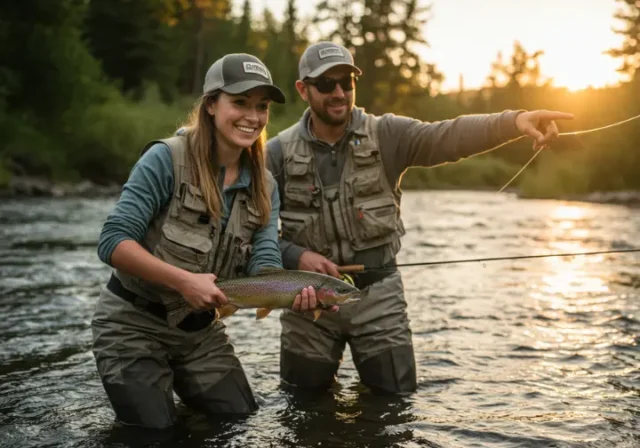In this article
You’re likely overlooking gear that transforms your trout game. Beyond a rod and reel, invest in breathable waders and—critically—a wading staff; currents demand respect, and a staff unlocks access to better fishing spots. Polarized sunglasses aren’t optional—they reveal fish. Upgrade your net to a soft-mesh model; it boosts catch-and-release survival to 95%. Don’t dismiss fly fishing principles when using spinning gear—Woolly Buggers are highly effective! These small shifts elevate your success and protect these wild resources for years to come. More awaits if you continue to explore.
Unlocking Trout Fishing Success
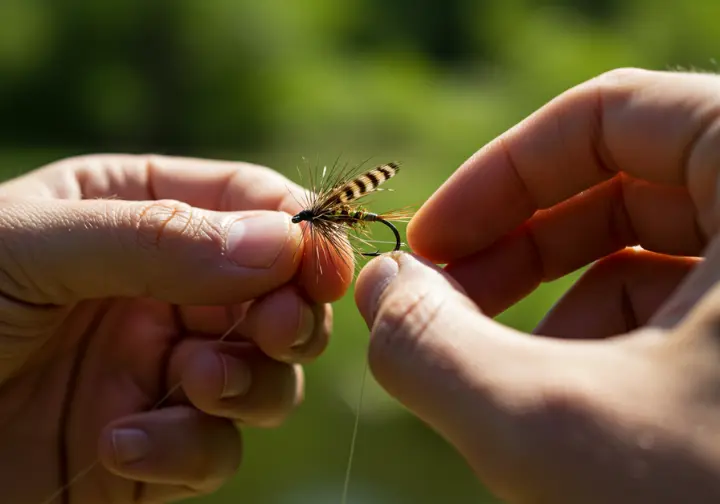
If you’ve ever felt like everyone else is catching trout while you’re stuck watching, you’re not alone. Unlock real fishing success by consulting a comprehensive trout fishing gear list and going beyond the basics.
Don’t just grab any fishing rod and fishing line; consider how specialized tools impact trout behavior. We’ve found that understanding this unlocks your fishing adventure.
Many stick to standard fly fishing techniques, but subtle changes in your fishing gear make a difference. Think about a wading staff for stability in currents—it’s a game changer.
Polarized lenses cut glare, letting you see fish. Soft mesh nets protect their slime coat, crucial for catch-and-release.
These aren’t replacements for skill, but boosts. They’re hidden gems, letting you apply better fishing techniques and elevate your game. Mastering these will transform your time on the water.
Standard Trout Fishing Basics
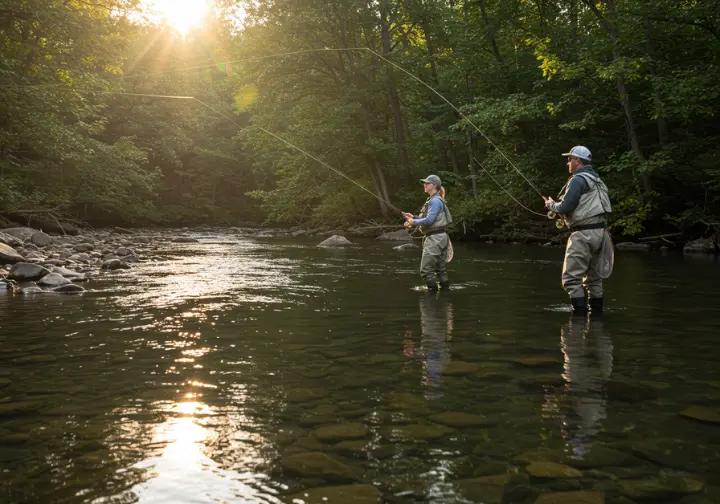
You’ll need to understand your basic gear before you hit the water, and we’re going to quickly cover what’s essential—rod, reel, line, and lures—to get you started.
Don’t think you can just grab any old tackle, though; some tools simply aren’t suited for trout’s smarts and delicate bites.
We’ll show you where conventional options fall short and how to choose gear that gives you a real edge, understanding that trout gravitate to areas providing protection and opportunities.
Essential Gear Overview
Though seemingly simple, gearing up for trout can feel overwhelming, even for those of us who’ve tied a fly for decades.
Building your trout fishing gear list starts with essential gear. You’ll want a lightweight 6-7 foot fishing rod and a 2000-series fishing reel spooled with 4-6 lb line.
Don’t forget waders—breathable chest-high ones keep you comfortable in chilly water. Considering options like stocking foot flexibility ensures comfort and dryness during extended fishing trips.
A fishing vest organizes your fishing accessories like hooks and indicators. A quality fishing net is crucial for safe fish release.
Many trout fishing gear lists stop there, but remember these are baseline tools. You’ll find standard setups work well in calm waters, but they aren’t always enough when conditions change.
Consider how your gear complements the specific trout streams you’ll be fishing. It’s about building a foundation, not settling for the minimum.
Limitations of Conventional Tools
While dependable, standard trout fishing gear often runs into trouble when conditions change—a frustration many of us know all too well. Your typical fishing gear, while a solid start, won’t always cut it.
Spinning rods can lack finesse for delicate presentations, and standard lures often fail in clear water where trout are wary of predators. Even waders, essential for accessing streams, don’t guarantee stability.
You’ll find basic gear lists often skip vital items like polarized sunglasses for spotting fish and assessing aquatic insects. Standard bait lacks scent enhancement, missing a key trigger—trout can smell incredibly well!
Plus, harsh fishing nets can harm fish, hindering catch-and-release fishing efforts. Adapting your fly selection, such as utilizing a Wooly Bugger streamer fly, can dramatically improve your success rate when standard methods fail to entice trout. Don’t fall into the trap of believing a simple gear list covers all your fishing tactics; adaptability is key. You need to be prepared for anything!
Elevating Your Trout Fishing Gear List
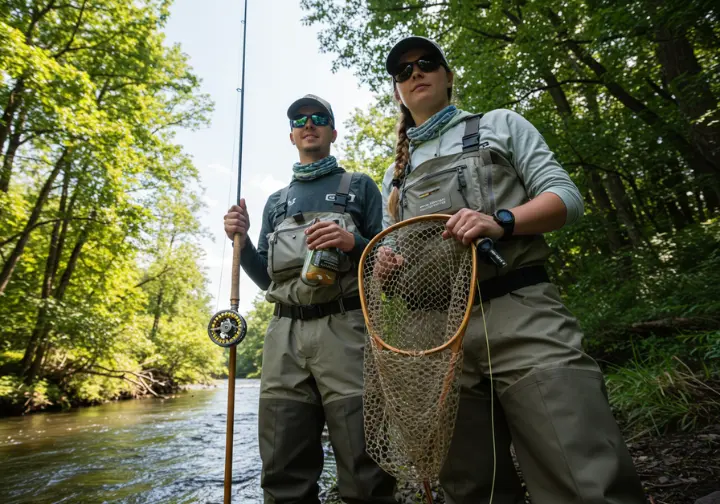
You’ve mastered the basics, now it’s time to refine your approach and catch even more trout.
Don’t underestimate how adding artificial flies to your spinning setup can unlock new presentations and entice finicky fish.
Plus, you’ll find you gain confidence—and safety—when you’re navigating slippery riverbeds with a reliable wading staff. Understanding how fly choices differ based on target species and location can dramatically improve your success rate, as generic flies may not always be sufficient.
Artificial Flies with Spinning Gear
Combining the delicate art of fly fishing with the ease of spinning gear might sound unusual, but it’s a surprisingly effective way to boost your trout fishing success.
You can unlock a new level of versatility by tying artificial flies to your spinning gear. Think Woolly Buggers – typically for fly-fishing – now cast with your existing rod and reel! Add a split shot about a foot up your 2-4 lb leader to mimic a natural drift; this is key for enticing trout. It’s particularly effective when traditional fishing bait or spinners aren’t getting a bite.
Anglers report a 30% catch increase in pressured waters using this technique. Plus, a pack of flies is cheap! Don’t let initial rigging tangles discourage you—a bubble float simplifies things. You might just fish a 20-inch trout where other gear fails, and understanding streamer patterns can significantly improve your chances of landing a trophy fish.
Wading Staffs for Stability
Though often overlooked in standard gear lists, a wading staff is a simple addition that can dramatically improve your time on the water—and keep you in the water.
Don’t underestimate this safety game-changer, especially when tackling fast, rocky streams during your trout fishing adventure. It’ll give you balance where waders alone won’t cut it. You’ll reach spots others can’t!
Consider these benefits:
- Increased stability navigating slippery rocks.
- Access to deeper runs for bigger trout.
- Reduced fall risk (reports show a 40% decrease!).
- Easily clips to your fishing vests or belt.
A collapsible wading staff, like Simms’ model, folds to 12 inches, so it won’t hinder your river/ shore fishing or bother your fly rod and fly reel, and is especially useful when targeting cold-water species like trout in mountain streams. It’s essential sport fishing gear for safer, more productive fishing escapades.
Enhancing Catch and Conservation
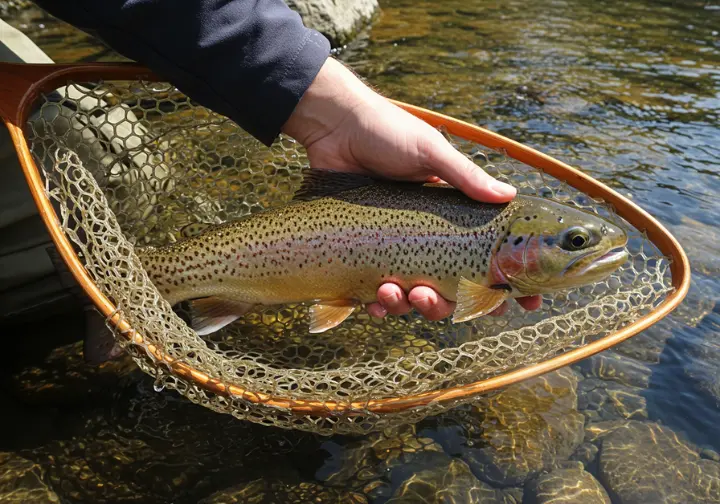
You’ll find more success—and help the fish you chase—when you focus on how you *see* and handle trout.
Polarized sunglasses cut glare, letting you spot fish holding in the current, while reducing eye strain over long days on the water.
Switching to specialized soft-mesh nets is a small change that drastically lowers fin and scale damage, ensuring they swim away strong for another angler’s chance.
Selecting appropriate fishing rubber boots is also critical for both angler safety and responsible interaction with the environment, providing necessary traction and protection when wading.
Polarized Sunglasses for Visibility
They’re essential for sight fishing, preventing you from spooking trout in the water.
Don’t underestimate their impact; Domenick Swentosky calls them the difference between guessing and knowing.
Consider these points:
- Enhance your ability to find trout.
- Minimize spooking wary fish.
- Improve your overall fishing experience.
- Choose amber lenses for low-light conditions.
For fly-fishers, investing in quality polarized sunglasses isn’t just about catching more fish–it’s about respectful fishing, particularly important when practicing careful catch and release to help maintain the river’s health.
Specialized Soft-Mesh Nets
Recent studies show 95% of trout-fishing catches—like that prized brown trout—are released unharmed with soft nets, versus only 60% with nylon.
Think about safeguarding wild fish like cutthroat trout.
While they cost more ($50-$150) than basic $20 options, investing in quality fishing gear like a Fishpond Nomad pays off. You’re not just landing fish; you’re ensuring future generations can too. It’s a small change with huge conservation benefits. Choosing the right net construction is vital, as hand-tied construction contributes to a gentler capture and less harm to the fish’s protective slime coat.
Key Takeaways and Next Steps
Considering the often-overlooked additions to a trout setup—like pairing flies with spinning gear, bringing a wading staff, donning polarized sunglasses, or netting fish with soft mesh—can genuinely elevate your time on the water.
You’ll find these aren’t just nice-to-haves; they directly impact your trout fishing success. Don’t underestimate the power of the right gear for your next trout fishing trip.
Here’s what you need to remember moving forward:
- Improve safety with a wading staff.
- Increase your catch rate using polarized sunglasses.
- Protect the trout with a soft-mesh net.
- Consider flies even if you prefer a baitcasting reel or fishing boat.
Now, put this knowledge to work! Upgrade your necessary trout fishing kit with even one of these various fishing accessories and assorted streamside tools. Share your experiences—what worked for you?
Popular Questions
Can I Use Saltwater Tackle for Trout?
How Do I Store Fly Lines Properly?
What Knot Is Best for Light Tippet?
Is Polarized Glass Better Than Polycarb?
How Often Should I Replace My Leader?
We are a participant in the Amazon Services LLC Associates Program, an affiliate advertising program designed to provide a means for sites to earn advertising fees by advertising and linking to Amazon.com. As an Amazon Associate I earn from qualifying purchases. We also participate in other affiliate programs. The information provided on this website is provided for entertainment purposes only. We make no representations or warranties of any kind, expressed or implied, about the completeness, accuracy, adequacy, legality, usefulness, reliability, suitability, or availability of the information, or about anything else. Any reliance you place on the information is therefore strictly at your own risk. Additional terms are found in the terms of service.


